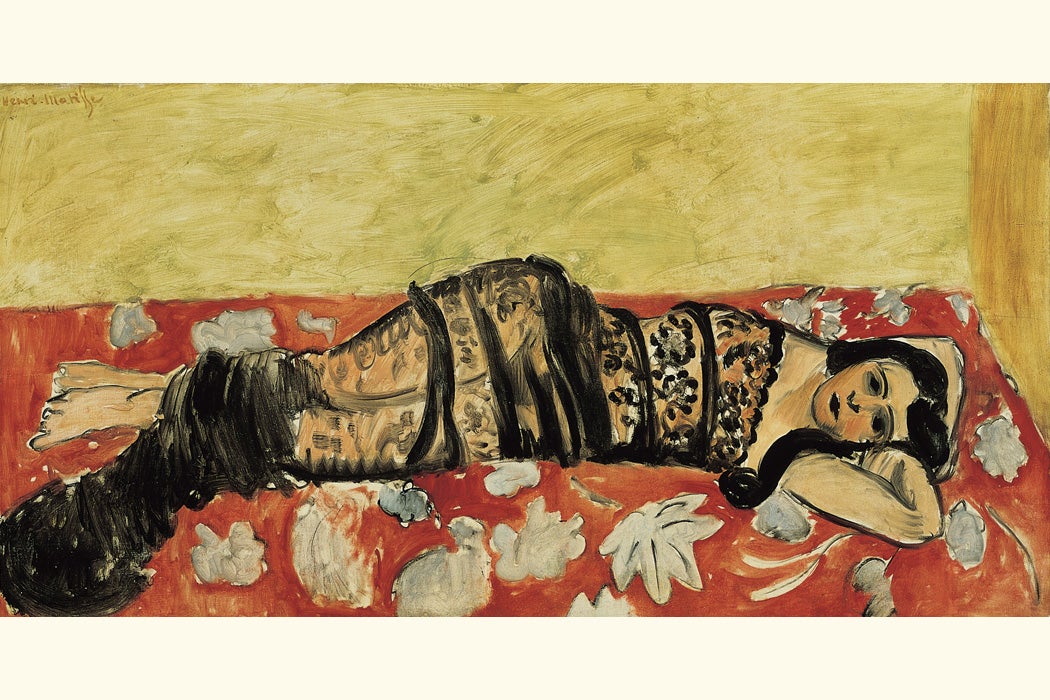Is the odalisque inherently problematic? As the dictionary defines it, odalisque refers to a female slave or member of a harem, but Steven E. Katz argues that the term has been used “more loosely” in the world of art to simply mean “a reclining nude female figure.”
In museums and art history texts, such terminology and subject matter (which most often is imagined and painted by white European male painters) goes largely unchecked. The Norton Simon Museum has a small-scale upcoming exhibit focused on paintings of odalisques by Henri Matisse and other prominent artists. The museum’s promotional material merely nods to the complications behind such imagery: “These erotic images of women in the geographically vague ‘Orient’ evoked a life of luxury and indolence far removed from nineteenth-century industrial society (and twenty-first century standards of representing race and gender).”
Other historians and writers overtly discuss the problematic nature of white Europeans not only inventing and exploring sexualized fantasies of prostitutes in foreign locales, but also inviting viewers to take pleasure in these desires. In 2015, writer and poet Najwa Ali explored Matisse’s odalisques, looking to the underlying violence of such imagery and representation. With pointed, lyrical prose, Ali introduces the subject of the odalisque in terms the average reader would understand:
The prostitute, over and over again. Fetish, sign of the flâneur’s movement, his ability to enter a netherworld, his ability to move anywhere. The prostitute. I think about her all the time. Enter her world through their eyes. The woman who moved, who was moved, who opened her legs or had them opened for her.
She explores the complications not only of Matisse’s oeuvre but also of his historiography as she compares his sexualized imagery to his noble image. “And yet, over and over, Matisse proclaims art to be a space of calm and beauty—an armchair for a tired businessman.”
Ali imagines her own very different relationship to the women in the paintings.
I am no businessman, but I, too, have lingered with these women, longed to touch the canvas, recognized my own breasts in them, those of the women I have touched. I, too, have been seduced by the quiet. A place we could have been.
She details Matisse’s trips to the then-French colonies in North Africa, like a 1909 trip to Biskra, Algeria, where he saw “girls come down to the oasis and rent out their bodies to raise money for their dowries.” Or his 1912 trip to Tangier, Morocco, “where all the White artists gather in search of adventure, experience, to make art in places now open to Europeans. This strange world that is now accessible, visible, recordable.”
Get Our Newsletter
Of these trips, Matisse documents only what he wants and what he imagines. Ali insists that readers do not forget this when looking at his odalisques and still lives. “There are massacres—somewhere outside the frame. Matisse complains only of weather. Paints flowers obsessively and sometimes Zohra, the local girl, maid, prostitute, whatever. Zohra.”
In the era of #MeToo, many viewers are beginning to question what is in fact outside the frame. What were the underlying colonial agendas of the time and how did these influence European male desire and fantasy? How does the colonial endeavor play out across the female body, aesthetically hiding the violence just beneath the surface? One wonders what structures of power—both patriarchal and colonial—are reinforced when we celebrate such imagery without interrogating the history behind it.







